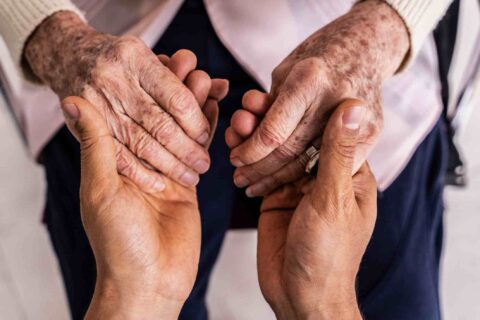Understanding Pain Management in Hospice for End-Stage Illnesses
Pain Management for End-Stage Illnesses in Hospice Care
We all experience some level of pain occasionally, whether it’s as small as stubbing our toe or as big as living with chronic pain. Pain management techniques are important at all stages of life, but especially in hospice care. The primary goal of hospice is to prioritize comfort and increase quality of life at the end of life, which means proper pain management is essential. At Agape Hospice NW, we strive to provide hospice pain relief to Portland, OR, families. Here’s what you need to know about hospice and how we can help your loved one live as comfortably as possible.

What Is Pain Management in Hospice?
Pain management in hospice refers to the strategies and treatments used to reduce discomfort and improve the well-being of those with end-stage illnesses. Unlike traditional health care, which may focus on curing the disease, hospice care emphasizes symptom relief and enhanced quality of life. By addressing pain, we aim to decrease the physical and emotional toll, leaving more opportunities to focus on what really matters at the end of life.
How Do You Approach Pain Management?
Hospice pain management takes several forms depending on the patient’s unique circumstances. When you come to us for care, we’ll evaluate your loved one and may recommend a combination of the following:
- Medication—Medications are a go-to solution for all kinds of pain. Once we understand the level of pain your loved one is dealing with, we can prescribe something to target the issue.
- Massage Therapy—Massage is an excellent way to relax tense muscles and promote better circulation.
- Guided Relaxation—Some folks in hospice benefit greatly from meditation and mindfulness. A member of our team can show you some strategies.
- Individualized Pain Plans—Every patient’s pain management plan is tailored to their specific needs. This includes considering underlying medical conditions, personal preferences, and religious or cultural considerations.
Working Together to Provide Hospice Pain Relief
Pain management for hospice patients looks different depending on an individual’s circumstances. However, one thing remains the same—a multidisciplinary care team will be at your loved one’s side to keep them as comfortable as possible. Here are a few professionals who might work with you and your loved one in hospice:
- Nurses—Hospice nurses will likely be your main point of contact throughout the process. These professionals monitor your loved one’s comfort each day, administer medications, and adjust to any changes in their condition.
- Physicians—Your loved one’s physician will play a big role in hospice pain relief. At Agape Hospice NW, we work closely with medical providers to balance pain relief tactics with chronic condition management.
- Social Workers—It’s hard to overstate the importance of hospice social workers. These professionals provide emotional support and help patients and families manage practical challenges related to end-of-life care. They may also offer bereavement services.
- Chaplains and Counselors—Pastoral care and counselors can help your loved one address spiritual and religious concerns as they near the end of their lives. Chaplains and counselors may also be a resource for families dealing with grief.
What Are the Challenges of Pain Management in Hospice?
Modern pain management techniques are quite effective, but even in the best of cases, we may run into some challenges. Thankfully, our team is trained to take on these difficulties and find ways to provide hospice pain relief anyway. Ask us how we address:
- Communication Barriers—Some hospice patients lose the ability to speak over time, but our team understands how to rely on nonverbal cues like facial expressions to gauge discomfort.
- Medication Side Effects—Some medicines have unwanted side effects like drowsiness or nausea. We work with you and your loved one to find a balance between pain relief and quality of life.
- Cultural Preferences—Cultural sensitivity is crucial to us. The Agape Hospice NW team strives to understand each patient’s beliefs and how they impact end-of-life care preferences.
Supporting Patients and Families Through Pain Management
Pain management for hospice patients also has implications for their families. Educating and involving family members is often the key to building trust and making sure everyone feels supported. At Agape Hospice NW, we’re glad to be a source of information for family caregivers. We’re here to answer your questions and provide regular updates about your loved one’s condition. If you have any concerns, don’t hesitate to reach out to our compassionate team.
Answering Your Hospice Pain Management Questions
It’s only natural to have questions about hospice and any pain management guidelines. You can always count on us to answer your concerns. Take a look at some of our FAQs or get in touch with us to learn more.
What Pain Medications Do You Use?
The type of medication your loved one will receive depends entirely on their unique condition. We might use mild medications like acetaminophen or strong opioids, depending on the severity of the pain.
Does Hospice Pain Management Eliminate All Pain?
While hospice care aims to significantly reduce pain, complete elimination may not always be achievable. Rest assured, we’re always working to maximize your loved one’s comfort.
How Do You Monitor Pain in Patients Unable to Communicate?
Hospice staff rely on non-verbal cues like facial expressions, restlessness, and physiological signs (such as heart rate) to assess pain if a patient can no longer communicate.
Are Non-Medication Pain Relief Methods Effective in Hospice?
Sometimes. Non-medication methods like massage, mindfulness, and heat therapy often complement medications in providing holistic pain relief. However, their effectiveness will vary based on your loved one’s condition.
Learn More About Hospice Pain Management
Thinking about a loved one in pain is something none of us wants to do. Nevertheless, planning for pain management in hospice can make a big difference in their quality of life. At Agape Hospice NW, we strive to take some of the stress off your shoulders by offering in-home pain management strategies and comprehensive hospice care. Contact us today to find out if our services are right for your loved one.


